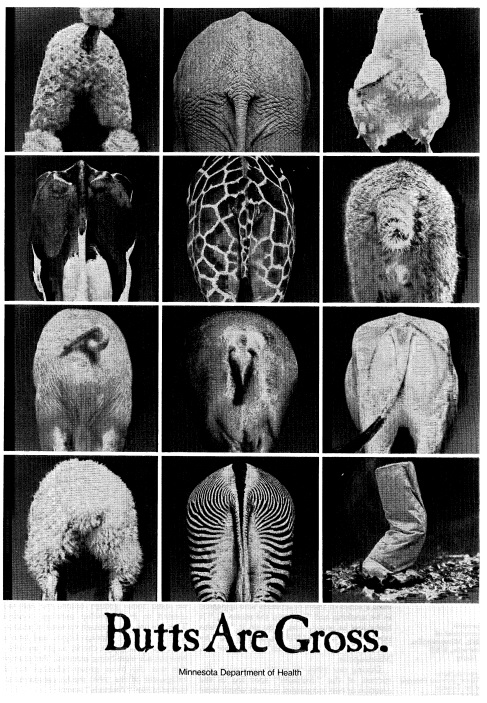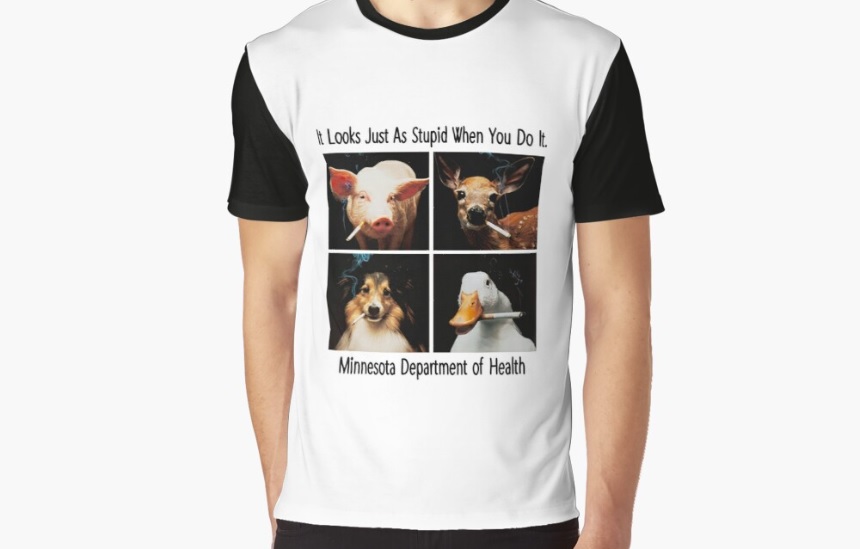Erin McHenry is very aware of her department's 33-year-old ad campaign.
"Ahhh yes, we still get requests sometimes from the public for copies of this!" the Minnesota Department of Health PR rep says. She's referring to the anti-smoking "Animals" poster the department released in 1989, which depicts a pig, a deer, a dog, and a duck puffing on cigarettes.
The campaign has recently taken on a new life... though its intended message—"It Looks Just As Stupid When You Do It"—may have been lost to irony and time.
Just look at this recent viral post:
Minnesota Department of Health crazy for this😭 pic.twitter.com/IaPGSFDidm
— Hating Within Context ⁶𓅓 (@ContextHating) April 7, 2022
Or, more to the point, this one:
They look badass pic.twitter.com/k6ARRQoZYK
— Rob (@houellebecq_2) May 29, 2022
The shirts take their design from a poster that accompanied a 1989 Minnesota Department of Health TV PSA, which is featured below in all its blues-riffing, cig-puffing glory. One of the spinoff "Animals" posters showcases, "12 domestic and exotic animals smoking. The other displays a series of discreetly executed photos of animals' posteriors and a picture of a cigarette butt," Kathleen Harty, the leader of MnDOH's anti-smoking division, wrote in a 1993 cover essay for Tobacco Control.
By all accounts, the award-winning campaign from Minneapolis-based ad firm Martin-Williams was a runaway hit. More than 20,000 posters were distributed during the first two days of the '89 Minnesota State Fair, Harty writes, and the 30-second TV spot would air in all 87 counties throughout the early '90s.

Harty became something of an anti-smoking star during that decade. The Chicago Tribune detailed her journey from a farm in Blooming Prairie, to hitchhiking across Europe as an anti-war activist, to eventually leading the country's first state-funded tobacco prevention program. The crux of her department's messaging was to "stress the idea that that tobacco use is both unattractive and socially unacceptable," Harty told the Strib in 1987. Billboards with copy like "Kiss the girls and make them cry" helped drive that home.
When the program launched in 1986, it drew an annual budget $1.6 million from the state's cigarette tax, though that would dwindle to $321,000 by 1992. The legislature yanked ad funding the following year.
In 1998, tobacco companies would unintentionally bankroll that space in mega-dollar fashion following Minnesota's landmark $6.5 billion lawsuit against 'em. Over $200 million of that settlement would go to ClearWay Minnesota, an anti-smoking nonprofit that shut down late last year. The state still operates Quit Partner MN, and its tone strives to be "supportive and empathetic," MnDOH's McHenry tells us. "Recent research," she explains, "indicates that portraying commercial tobacco products, like cigarettes, in counter-marketing ads may undermine their effectiveness, as they can activate cravings."
And yes, the current online reading of the "Animals" campaign seems to suggest that the cig-dangling beasts look cool as hell. ("The animals were treated with complete respect," Harty writes, nothing that a vet was on set and prop smokes were affixed with surgical glue or special rubber bands.)
"Ridiculous? This was so cool I bought a carton and I’m on the way to the zoo," reads one YouTube comment.
"This makes me want to smoke," adds another.
"I would love a T-shirt of basically any frame from this video," states the top-voted comment. "Million dollar idea," reads the reply.
Savvy online vendors have sensed that demand. Over 800 people have favorably reviewed this $23 T-shirt on Redbubble; almost 200 have raved about an identical $20 design on Etsy. "Oh, we found that shirt interesting, and thought everyone would love it!" Etsy creator Mesa Arts Design tells us. It's unclear what sort of murky copyright territory these knockoffs might be wading in, but the companies that facilitate their sales don't seem to care. "We love seeing artwork become popular and go viral because we are committed to giving artists a simple and efficient way to DESIGN AND SELL PRODUCTS, while adding a little more creativity to the world," a Redbubble spokesperson tells us. (Emphasis theirs.)
Or, in this case, the late-'80s creativity of a Twin Cities ad firm.
"The 'Animals' ad was unlike any other ad we had ever tested in that it worked well with all racial groups and both sexes," Harty wrote in '92. "In all of the groups, the initial reaction to the ad was laughter."
The laughter element remains undeniable to this day.







